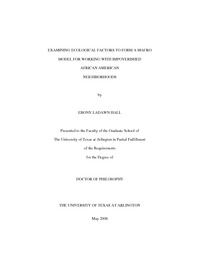
ATTENTION: The works hosted here are being migrated to a new repository that will consolidate resources, improve discoverability, and better show UTA's research impact on the global community. We will update authors as the migration progresses. Please see MavMatrix for more information.
Show simple item record
| dc.contributor.author | Hall, Ebony Ladawn | en_US |
| dc.date.accessioned | 2008-08-08T02:31:18Z | |
| dc.date.available | 2008-08-08T02:31:18Z | |
| dc.date.issued | 2008-08-08T02:31:18Z | |
| dc.date.submitted | May 2008 | en_US |
| dc.identifier.other | DISS-2094 | en_US |
| dc.identifier.uri | http://hdl.handle.net/10106/995 | |
| dc.description.abstract | This social science study examines three ecological factors (geographical, institutional, and social) of impoverished African American neighborhoods, while also assessing the differences of poor neighborhoods with lower amounts of poverty and those with higher amounts of poverty. Twelve of the poorest neighborhoods in Mobile and Prichard, Alabama were included in the study. The ecological factors included 1) geographical variables determined by the average age of the homes in neighborhood, number of hazardous areas, the number of unoccupied units, and the structural integrity of the neighborhood, 2) institutional variables determined by the number of operating businesses, churches, medical facilities, social organization, schools and the quality of the schools and 3) social variables determined by the neighborhood connectedness, peer support, friend attachment, warmth toward mother, warmth toward father, and religious affiliation. The amount of poverty was assessed using three different measures analyzed independently of one another:
Median incomes of the impoverished neighborhoods
Percentages of individuals with incomes below poverty threshold
Percentages of individuals with incomes less than half of the poverty threshold (extreme poverty)
The analysis included correlations among variables to assess strength of association, one-way ANOVAs to assess differences among groups, and linear regressions to assess explanations of the amount of poverty. Several significant findings were apparent with educational quality within these impoverished areas. The findings bring about new facets for consideration in terms of impoverished African American neighborhoods, especially those neighborhoods with higher rates of extreme poverty. Although limitations were apparent, the study also yielded paramount implications for the social work profession relating to churches, schools, and current government initiatives. | en_US |
| dc.description.sponsorship | Scannapieco, Maria | en_US |
| dc.language.iso | EN | en_US |
| dc.publisher | Social Work | en_US |
| dc.title | Examining Ecological Factors To Form A Macro Model For Working With Impoverished African American Neighborhoods | en_US |
| dc.type | Ph.D. | en_US |
| dc.contributor.committeeChair | Scannapieco, Maria | en_US |
| dc.degree.department | Social Work | en_US |
| dc.degree.discipline | Social Work | en_US |
| dc.degree.grantor | University of Texas at Arlington | en_US |
| dc.degree.level | doctoral | en_US |
| dc.degree.name | Ph.D. | en_US |
| dc.identifier.externalLink | https://www.uta.edu/ra/real/editprofile.php?onlyview=1&pid=621 | |
| dc.identifier.externalLinkDescription | Link to Research Profiles | |
Files in this item
- Name:
- umi-uta-2094.pdf
- Size:
- 28.01Mb
- Format:
- PDF
This item appears in the following Collection(s)
Show simple item record


